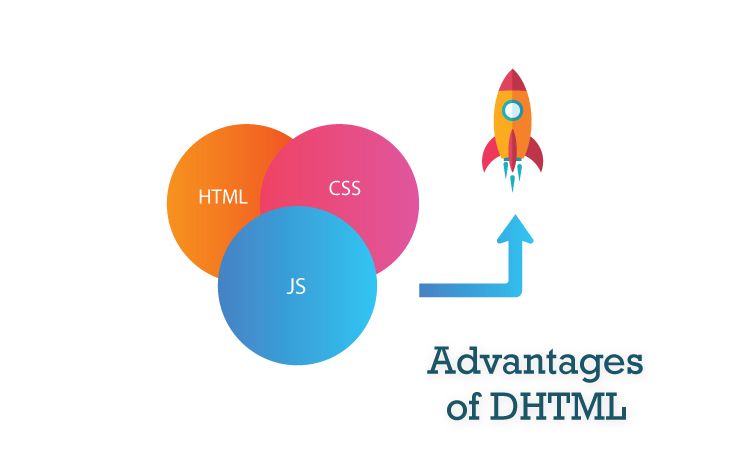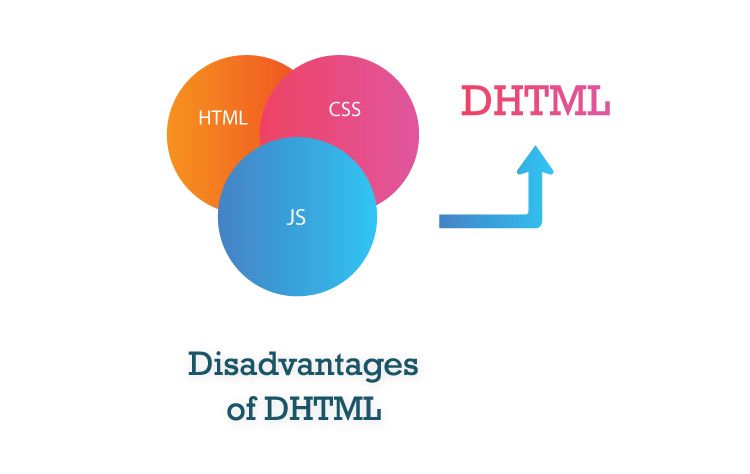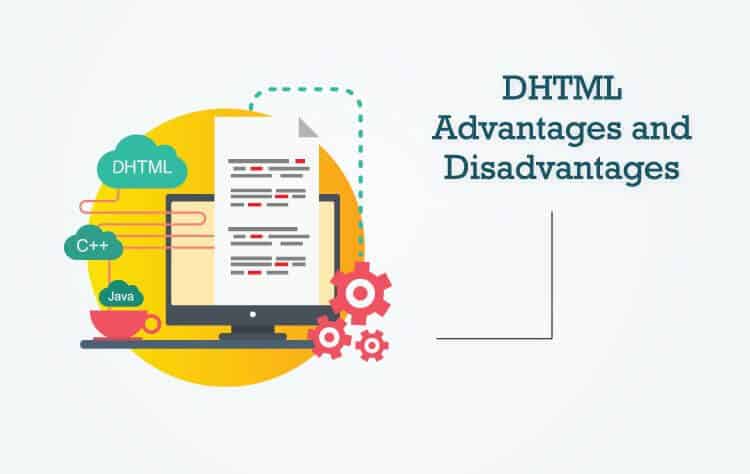So you landed on this page.
That means there are certain questions revolving around your mind.
Is DHTML dead? What has happened to it?
The answer is nothing.
It was an old buzzword that got replaced by the more advanced model like AJAX.
However, it’s still the base of web development standards that are followed today.
We aren’t travelling the way back machine here. However, we are going to discuss the major advantages & disadvantages that made DHTML faces as well as the reasons for its discontinuation.
Table of Contents
- First, what is DHTML?
- Components
- What are the common features of DHTML?
- Is DHTML dead with Microsoft’s Internet Explorer?
- DHTML Applications – Use Cases
- FAQs
First, what is DHTML?
Dynamic HTML or DHTML is nothing but an extension to plain HTML. To clear doubts, it’s neither a programming language nor a markup language.
Simply, it’s a process to make a static web page dynamic and interactive by combining technologies like HTML, CSS, client-side scripting language, and DOM.
DHTML allows integrating scripting languages with HTML to change variables which makes a static web page look more aesthetic.
Components
DHTML technology combines several other technologies to produce dynamic and interactive content on the web. Each component serves a particular purpose in the creation of DHTML-based web apps.
HTML stands for Hypertext Markup Language. HTML is the building block of computer creation. It uses tags and properties to provide the fundamental framework and text of a web page. Because HTML is a static markup language, the information is set and does not alter constantly.
JavaScript is a programming language that adds animation and dynamic behaviour to websites. You can use JavaScript to make animations, verify forms, modify the DOM, and perform other activities that improve the user experience. The main language for developing DHTML apps in JavaScript. CSS (Cascading Style Sheets): CSS is a language for controlling the appearance and structure of a web website. This enables you to separate the presentation of a web page from its text, making adjustments to the look of a website simpler. CSS is used to design HTML components as well as to create visual effects like animations and transitions.
The DOM (Document Object Model) is a computer interface that lets JavaScript communicate with HTML and XML texts. It depicts a web page’s structure as a tree of objects that can be viewed and manipulated with JavaScript. The DOM allows you to alter the content, structure, and design of a web website automatically based on user interactions.
In summation, HTML provides content, CSS provides style, JavaScript provides behaviour, and the DOM provides an interface for getting and changing a web page’s content and style. These components, when combined, constitute the basis of DHTML-based web apps.
Advantages of DHTML

- In comparison to other multimedia software like Flash and Shockwave, it took less space. Those resulted in a short download time which saved bandwidth as well as made the website quick.
- DHTML was fast & zippy depending upon your device and ISP. You didn’t need an extra plugin to make it work efficiently as it used the features present in the browsers. The content is loaded on the fly. The whole page didn’t load promptly and saved time for end-users by altering just the content part.
- It was supported in some form or shape by major browsers from Microsoft, and Netscape. It also worked well with cell phones, PDAs, and PDFs.
- DHTML was considered to be design-friendly offering web designers different options to give web pages a compact look. It had more advanced functionality than static HTML & holds more content on the web page at the same time.
- What made DHTML famous at its prime was its outlook. It was popular among clients due to its sleek nature & flexibility to make changes to their data.
- Due to low file maintenance, it saves time for web designers and is more efficient for content management. The use of dynamic XML made the high volume of content look reasonable avoiding any lag.
Learn from the mistakes: 5 Common mistakes in web design
Disadvantages of DHTML

- DHTML was great with functionality. However, it still required a few utilities and tools that used to come at a heavy price. An example of a DHTML text editor is Dreamweaver which ranges from $19.99 per month. Also, the training and improvement cost for transferring from HTML to DHTML makes the cost rise much higher.
- The long and complex coding structure can be daunting for a few. You need to be well versed in HTML, JS, & CSS to produce a better output.
- DHTML suffers from browser compatibility. What works for Netscape may not work on IE. If you don’t make a compatibility check while writing codes, the output may be a mess.
- It was mainly used for animation on web pages. However, due to the problem of web languages, DHTML didn’t perform too well with every platform.
That started as a buzz has faded away and been replaced by many advanced Software and languages. However, the module we use in today’s web development follows the pattern of DHTML which makes it one of the greatest predecessors.
What are the common features of DHTML?
- The main goal of DHTML when it was first rolled out was to help build dynamic pages.
- You can also build a dynamic website using DHTML without adding any additional plugins or codes or CMSs
- It also offers reusable code blocks that you can expand more than HTML.
- It doesn’t take many resources and can load faster as opposed to new CMSs and heavy databases.
- It can be used to create simple animations, applications, and games and provides some interactive ways to build website navigations.
Is DHTML dead with Microsoft’s Internet Explorer?
When Internet Explorer came about they used DHTML and AJAX to make the website interactive and interesting. After 26 years, Microsoft has put Internet Explore to sleep in 2022.
DHTML Applications – Use Cases
DHTML is frequently used to build dynamic user displays that react to user inputs. Animations, hover effects, drop-down buttons, and other dynamic components that improve the user experience are examples of DHTML use. DHTML is also used to build web-based games that can be played immediately in a web browser. Developers can use DHTML to build interactive and engaging games that are available to a broad variety of users.
Web-Based apps: DHTML is widely used to build responsive and interactive web-based apps. Online forms, data displays, and other apps that demand user input and involvement.
DHTML can also be used to generate dynamic content that alters in real-time in response to user interactions or other occurrences. This includes real-time alerts, live updates, and other material that needs frequent updates.
Web Animations: DHTML can be used to make aesthetically attractive and useful animations and transitions. Scroll movements, picture sliders, and other animations that improve the user experience are examples of this.
DHTML is frequently used to build web apps that function smoothly across multiple platforms and devices. Developers can use DHTML to build web apps that are optimised for both desktop and mobile platforms without the need for distinct code bases.
Learn essential techniques for backing up your WordPress site and gain peace of mind knowing your data is protected from unforeseen incidents with our complete WordPress Backup Guide.
FAQs
What is the purpose of DHTML? What are the benefits of using DHTML in web development?
DHTML can create dynamic and interactive web content that responds to user interactions and helps to provide a better user experience. These are some of the benefits you can get by using DHTML; improved performance, enhanced user experience, cross-browser compatibility, and the ability to create dynamic content and interactive user interfaces.
How does DHTML work?
DHTML works by combining it components; HTML, CSS, JavaScript, and the Document Object Model (DOM) to create dynamic and interactive web content. JavaScript is used to manipulate the DOM and change the content, structure, and style of a web page based on user interactions.
Is DHTML still relevant in modern web development?
Yes, DHTML is still relevant in modern web development as it’s a foundational technology that is widely used to create dynamic and interactive web content.
How can I learn DHTML?
To learn DHTML, you can start with studying the individual components, including HTML, CSS, JavaScript, and the Document Object Model (DOM). There are many online resources available, including tutorials, courses, and documentation.



